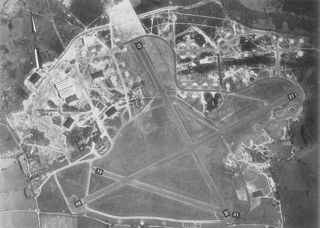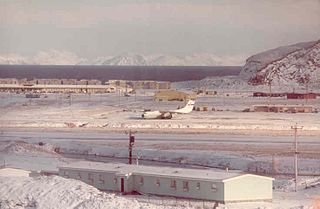- Annette Island, Alexander Archipelago
- Built 1941, opened 1 March 1942. AAF/Civil joint-use airport used as refueling/servicing of transport aircraft between Washington State and Elmendorf. The Royal Canadian Air Force, through its RCAF Western Air Command, operated fighter and bomber aircraft from here, backing up US units closer to the Japanese occupied islands. RCAF 115 Squadron flew Bristol Bolingbroke aircraft; RCAF 118 [2] [3] and 135 Squadrons flew P-40s. 149 Squadron operated Lockheed Ventura torpedo bombers. [4] Closed 1945 and turned over to War Assets Administration for disposition, 1946. Jurisdiction transferred to private ownership in 1947 and now Annette Island Airport.
- Bethel, Alaska Territory
- Construction began 21 September 1941, activated 4 July 1942; Used by Air Transport Command as auxiliary airfield for Lend-Lease aircraft being flown to Siberia; Transferred to Eleventh Air Force, then to Alaskan Air Command, 1945; became joint-use Bethel Airport, used for construction of AC&W Bethel Air Force Station in the mid-1950s. Full jurisdiction turned over to Alaska Government 1958, now a civil airport.
- Fairbanks, Alaska Territory
- Built 1942 for Air Transport Command; Host unit was 1465th AAFBU. Alaskan Division, ATC. Was used on Northwest Staging Route ferrying Lend-Lease aircraft; Also used by Eleventh Air Force for staging and emergency use. Transferred to Eleventh Air Force, then to Alaskan Air Command, 1945; transferred to United States Army 1948, now Fort Greely
- Cordova, Alaska Territory
- Construction began 22 June 1941, activated 1 April 1941. Became AAF/Civil joint-use airport used as refueling/servicing of transport aircraft between Washington State and Elmendorf. Closed 1945 and turned over to War Assets Administration for disposition, 1946. Jurisdiction transferred to private ownership in 1949 and now Cordova Municipal Airport.
- Gakona, Alaska Territory
- Emergency 3,000' rolled gravel landing strip bulldozed in 1943, located adjacent to Gakona, Alaska, aligned 03/21. Abandoned after the war, now the right-of-way is a part of Alaska Highway 1.
- Galena, Alaska Territory
- Constructed 1942 by Air Transport Command, Host unit was 1468th AAFBU. Alaskan Division, ATC. Was used as refueling/servicing airfield for transfer of Lend-Lease aircraft to Siberia; Also used by Eleventh Air Force for staging and emergency use. Transferred to Eleventh Air Force, then to Alaskan Air Command, 1945
- Gambell, St. Lawrence Island
- Constructed 1943 by Air Transport Command, used as refueling/servicing airfield for transfer of Lend-Lease aircraft to Siberia; Transferred to Eleventh Air Force, then to Alaskan Air Command, 1945 and closed, turned over to War Assets Administration for disposition, 1946. Jurisdiction transferred to private ownership in 1950 and now Gambell Airport.
- Juneau, Alaska Territory
- Opened on 1 July 1941 as a civil airport. Used as a military refueling/servicing stop for transport aircraft between Washington State and Elmendorf.
- Kiska Island, Aleutian Islands
- Captured Japanese airfield under construction at time of liberation, 1943. Completed by AAF Engineers and used as auxiliary transport airfield in Aleutians. Closed 1945 and abandoned.
- Fairbanks, Alaska Territory
- Constructed 1939, prewar mission was cold weather testing of aircraft and equipment; became Air Transport Command airfield in 1942, Host unit was 1466th AAFBU. Alaskan Division, ATC. Was main transfer point for Northwest Staging Route Lend-Lease aircraft from United States ATC pilots to Soviet Red Air Force pilots; aircraft then flown to Siberia after transfer. Transferred to Eleventh Air Force, then to Alaskan Air Command, 1945. In 1961 it was transferred to the Army and re-designated Fort Wainwright in honor of World War II general Jonathan Wainwright. From 1963 to 1972 it was home to the 171st Infantry Brigade, mechanized until 1969, then light. During that time, the 172nd Infantry Brigade was at Fort Richardson, in Anchorage. From 1986 to 1998 Fort Wainwright was the home of the 6th Infantry Division (Light), and served as the division's headquarters from 1990 to 1994. From 1998 to 2006, it was home to the 172nd Infantry Brigade, which was reorganized in 2003 as the 172nd Stryker Brigade Combat Team (SBCT), part of the U.S. Army's transition program to include six SBCTs. In 2006, the 172nd was re-flagged as the 1st Brigade of the 25th Infantry Division. Fort Wainwright is also the home of Task Force 49, an aviation brigade that provides logistical air support for U.S. Army Alaska, Bassett Army Community Hospital and the Bureau of Land Management's Alaska Fire Service.
| - Constructed 1941 by CAA a civil airport. Used as a sub-base of Ladd Army Airbase . Used by Air Transport Command as auxiliary airfield for Lend-Lease aircraft being flown to Siberia; Transferred to Eleventh Air Force, then to Alaskan Air Command, 1945; Full jurisdiction turned over to Alaska Government 1947, now a civil airport. Used as a staging facility for construction of AC&W Tatalina Air Force Station in the mid-1950s.
- Nome, Alaska Territory
- Constructed 1942, opened 1 July. Used by Air Transport Command as refueling/servicing airfield for Lend-Lease aircraft being flown to Siberia by Soviet Red Air Force pilots. Host unit was 1469th AAFBU. Alaskan Division, ATC. Renamed Marks Army Airfield, 1942. Transferred to Eleventh Air Force, then to Alaskan Air Command, 1945
- Moose Creek, Alaska Territory
- Constructed 1943 by Air Transport Command; activated on 20 September as Station #4, Alaskan Wing, was auxiliary to Ladd Army Airfield for Northwest Staging Route Lend-Lease aircraft. Transferred to Eleventh Air Force, then to Alaskan Air Command, 1945.
- Elim, Alaska Territory.
- Constructed 1943 as auxiliary landing strip for Marks AAF; Used as servicing airfield for Lend-Lease aircraft being flown to Siberia by Soviet Red Air Force pilots. Transferred to Eleventh Air Force, then to Alaskan Air Command, 1945 and closed, turned over to War Assets Administration for disposition, 1946. Jurisdiction transferred to private ownership in 1947 and now civil airport.
- King Salmon, Alaska Territory
- Activated 1 July 1942 by Air Transport Command. Was transport and maintenance airfield for ATC aircraft servicing Alaska airfields; also provided maintenance for transient aircraft in Alaska. Transferred to Eleventh Air Force, then to Alaskan Air Command in 1945. Became King Salmon Air Force Base.
- Northway, Alaska Territory.
- Constructed 1943 by Air Transport Command; Host unit was 1463d AAFBU. Alaskan Division, ATC. Mission was servicing Northwest Staging Route Lend-Lease aircraft from United States. Also used by Eleventh Air Force for staging and emergency use. Transferred to Eleventh Air Force, then to Alaskan Air Command, 1945 and closed, turned over to War Assets Administration for disposition, 1946. Jurisdiction transferred to private ownership in 1947 and now Northway Airport.
- Was forward airfield constructed on Ogliuga Island. Operational between 1943 and 1945, used during Aleutian Campaign between Kiska and Adak. The site included an emergency landing field, parking area, and living quarters. Additional facilities were established at this site, including aircraft warning, airway radio communication, and a weather reporting station. No permanent units assigned, abandoned. Reported hazardous munitions still remaining on island.
- Tanacross, Alaska Territory
- Constructed 1943, activated 20 September by Air Transport Command as Station #16, Alaskan Wing, later 1464th AAFBU. Alaskan Division, ATC. Was auxiliary to Ladd Army Airfield for Northwest Staging Route Lend-Lease aircraft. Designated Tanacross Air Base, July 1944. Mission was servicing Northwest Staging Route Lend-Lease aircraft from United States. Transferred to Eleventh Air Force, then to Alaskan Air Command, 1945 and closed, turned over to War Assets Administration for disposition, 1946. Jurisdiction transferred to private ownership in 1947 and now Tanacross Airport.
- Seward, Alaska Territory
- Constructed as part of Fort Raymond; closed 1948, turned over to War Assets Administration for disposition. Jurisdiction transferred to Territory of Alaska and now Seward Airport.
- Yakutat City and Borough, Alaska Territory
- Constructed 1941 as landing field for transport aircraft between Washington State and Elmendorf; activated on 1 March 1942; closed 1945, turned over to War Assets Administration for disposition, 1946. Jurisdiction transferred to private ownership in 1949 and now Yakutat Airport.
|














